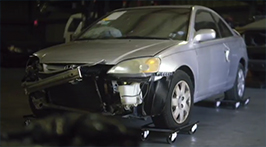Coffee makers are a common cooking appliances used for brewing of coffee within one convenient heating unit. The vast majority of the 14 million coffee makers sold in the United States each year are electrically operated automatic drip style machines. Including the automatic drip, below are the most popular types of coffee brewing appliances:
- Automatic drip – This most popular type of coffee maker consists of a chamber for water, a filtering basket for ground coffee, an operations switch and glass urn on a heating element. Some versions include automatic brewing programs set to a clock or timer, coffee bean grinding, automatic shut-off, and other such upgrades.
- Pod coffee makers – The newest version of automatic drip systems, little coffee packets called “pods” are inserted into the dispenser where hot water is filtered through the pod to create coffee which then flows into individual cups or a small carafe at the base of the machine.
- Espresso and cappuccino machines – There are many variations and models for espresso and cappuccino machines, such as manual stove top models, steam machines using steam to push hot water through coffee grounds, and electric units.
- Percolators – A single metal, electrically operated carafe contains a filter basket for ground coffee and the water is placed directly into the carafe. During heating, the water is forced throughout the unit and through the grounds. Percolators plug directly into the electric outlet, so the coffee is consistently heated as long as the unit is powered on.
Defects
Regardless of the type of coffee maker used, manufacturing and design defects pose major injury risk. Some of the most commonly seen risks during operation of coffee makers include:
- Electrocution due to faulty wiring or improper design
- Fire hazard from faulty wiring or electrical cords
- Burns associated with the hot water, heated coffee, electric components, burner or hot plate, and the unit itself
- Cuts and abrasions due to broken glass carafes
- Shifting parts such as filter baskets causing hot water overflows
General Product Failure
Coffee makers are notorious for being a source of burns and fire, especially when an automatic shut-off mechanism is not present in the machine. If the unit does not shut off or is not turned off after use, the unit may continue to heat the carafe and plastic parts. Burns, melting of components, and even home damage are not uncommon.
Some other examples of product failures commonly seen in coffee makers are:
- Thermostat malfunction within the coffee maker causes the coffee maker to continue heating and operation, even when manually shut off. The result is damage to the machine and surrounding home area through scorching, melting, and fire, as well as the potential for skin burns or even death due to resulting fire or electrocution.
- Cappuccino machines operate with high steam pressure. Coffee filter holders and baskets have been dislodged under standard operation due to faulty design and attachment, causing broken glass carafes, cut skin for users, and serious burns by escaping steam, coffee grounds, and coffee.
- Starbucks Coffee Company of Seattle recalled 73,000 eight cup coffee makers in 2006 due to defective electrical wiring known to cause overheating, smoking, burning, and melting.
Statistics of Failure
In 1998, a survey of home fire injuries and deaths revealed that 300 residential fires resulted from coffee makers, including 20 injuries. The total property damage attributable to coffee makers that year was $2 million. The same report for 1996 indicated that 500 residential fires were attributable to coffee makers, with total damages of about $4.4 million. Despite the drastic 40 percent reduction of the number of fires coffee makers caused by 1998, the same number of injuries continued to be seen in 1998 as in 1996. Both years consisted of 20 personal fire injuries associated with coffee maker-induced home fires.
Coffee makers are consistently recalled in cooperation with the Consumer Product Safety Commission in order to address defects in manufacturing and design. Some examples of defects which caused user death or injury include:
- In 1997, Health O’Meter/Mr. Coffee recalled 50,000 units of a popular espresso maker due to defective design of the metal coffee filter component. Three incidences of cuts and burns were associated with 43 separate reports of product failures.
- More than 18.5 million Corning Ware coffee makers were recalled in 1976 after 7,000 complaints were received regarding separation of the carafe handle from the glass carafe, resulting in 1,250 injuries.
- Gevalia Coffee Company of New York recalled 15,000 automatic drip coffee makers in 2001 after receiving 11 reports of overflow incidences, including eight burn injuries. One user suffered 2nd-degree burns.
